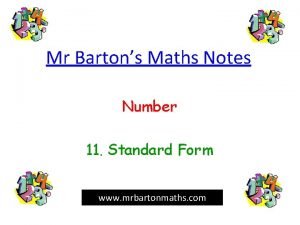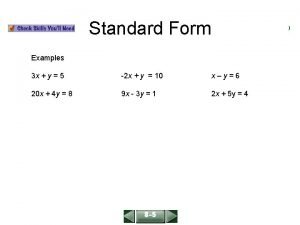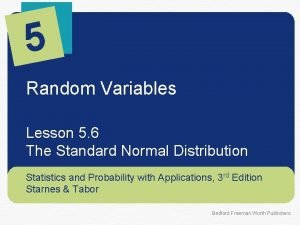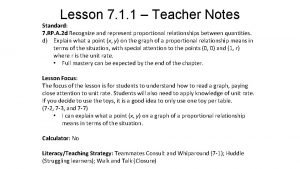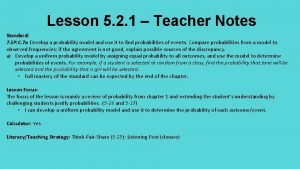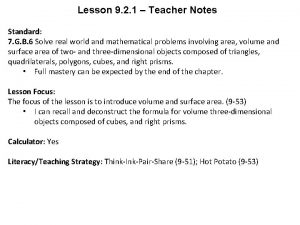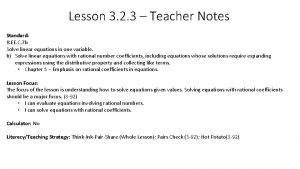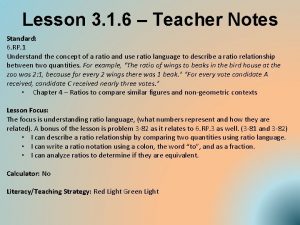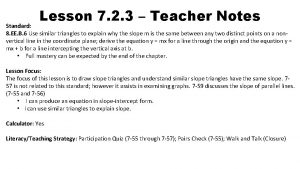Lesson 4 1 4 Teacher Notes Standard 8













- Slides: 13

Lesson 4. 1. 4 – Teacher Notes Standard: 8. EE. B. 6 Use similar triangles to explain why the slope m is the same between any two distinct points on a non-vertical line in the coordinate plane; derive the equation y = mx for a line through the origin and the equation y = mx + b for a line intercepting the vertical axis at b. • Chapter 7 – Emphasis on equations and slope. Lesson Focus: This lesson introduces slope-intercept form of an equation. It is also an introductory lesson of slope triangles. The Learning Log is an essential understanding of the lesson and would make for a great closure activity and a perfect way for teachers to ensure students understand the primary concept. (431, 4 -32, 4 -33, 4 -36) • I can write function rules in slope-intercept form. • I can draw slope triangles when given a graphed function. Calculator: Yes Literacy/Teaching Strategy: Think-Pair-Share (4 -31); Hot Potato (4 -33)


Bell work

In Lessons 4. 1. 2 and 4. 1. 3, you investigated connections between tile patterns, x → y tables, graphs, and rules (equations). Today you will use your observations about growth and Figure 0 to write rules for linear patterns and to create new tile patterns for given rules.

4 -30. With your team, list some of the equations you have been working with in the past two lessons. What do all of these rules have in common?

4 -31. UNDERSTANDING y = mx + b Rules for linear patterns can all be written in the form y = mx + b. In y = mx + b, x and y represent variables, while m and b represent parameters. Parameters are numbers that stay the same in the equation after they are chosen. Discuss these questions with your team: a. What does m tell you about the pattern? b. What does b tell you about the pattern?

4 -32. GRAPH → RULE Allysha claims she can find the equation of a line by its graph without using a table. How is that possible? Discuss this idea with your team and then try to find the equation of the line at right without first making a table. Be ready to share with the class how you found the rule. Rule: _________

4 -33. TABLE → RULE Allysha wonders if she can use the idea of m and b to find the equation of a line from its table. a. For example, if she knows the information about a linear pattern given in the table below, how can she find the equation of the line? Work with your team to complete the table and find the rule.

4 -33 Continued b. Use this same idea to find the rule of the linear tile patterns represented by the tables below. c. Write a summary statement explaining how you used your knowledge about m and b to quickly write a rule.

LEARNING LOG The linear equations you have been working with can be written in this general form: y = mx + b In your Learning Log, summarize what you know about m and b so far. What does the m tell you about a pattern? What does the b tell you about a pattern? Where can you see m and b in each representation? Sketch examples if it helps.

Practice


 Conversion notes brutes en notes standard wisc 5
Conversion notes brutes en notes standard wisc 5 Erf requirements for teacher 2, 2020
Erf requirements for teacher 2, 2020 Hello teacher good afternoon
Hello teacher good afternoon Adding standard form
Adding standard form Standard error definition
Standard error definition Home language and standard language
Home language and standard language Standard cost definition
Standard cost definition Kurikulum standard sekolah menengah
Kurikulum standard sekolah menengah Standard form examples algebra
Standard form examples algebra Lesson 5.6 the standard normal distribution
Lesson 5.6 the standard normal distribution Lesson outline lesson 3 describing circuits answers
Lesson outline lesson 3 describing circuits answers Lesson outline lesson 3 mountain building answers
Lesson outline lesson 3 mountain building answers Lesson outline lesson 2 aquatic ecosystems answer key
Lesson outline lesson 2 aquatic ecosystems answer key What is microteaching lesson plan
What is microteaching lesson plan



